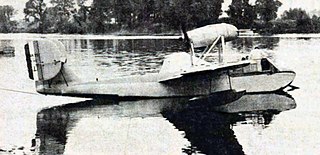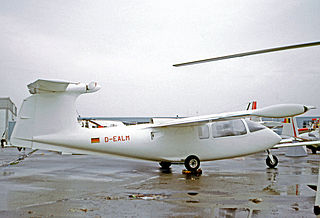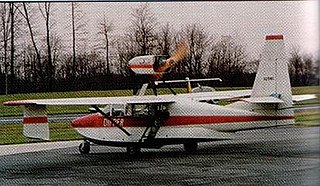
The RA-14 Loisirs was a French two-seat high-wing light touring aircraft designed by Roger Adam shortly after World War II.

The Aero Commander 100, various models of which were known as the Darter Commander and Lark Commander was a US light aircraft produced in the 1960s. It was a high-wing monoplane of conventional design, equipped with fixed tricycle undercarriage.

The PZL-105 Flaming (flamingo) is a Polish short-takeoff-and-landing (STOL) utility aircraft designed by PZL "Warszawa-Okęcie". It remained a prototype.

The Luton L.A.5 Major was a 1930s British two-seat high-wing cabin monoplane. Following World War II, plans were made available to suit construction as a homebuilt aircraft.

The MBB Bo 209 Monsun is a two-seat light aircraft that was developed in West Germany in the late 1960s.

The Colonial Model C-1 Skimmer was an American small single-engined amphibian flying boat built by the Colonial Aircraft Corporation. It was the start of a line of very similar aircraft designed by David Thurston.

The Cvjetkovic CA-65 Skyfly is a 1960s American homebuilt monoplane aircraft designed by Anton Cvjetkovic.
The Falconar AMF-S14 Maranda is a two-seat, light aircraft first flown in Canada in 1961 and originally marketed for amateur construction by Falconar Avia.

The SCAN 20 was a 1940s French flying-boat training monoplane designed and built by Société de Constructions Aéro-Navales de Port-Neuf (SCAN). The prototype was built in secret in 1941 it was hidden until the liberation of France and first flown in 1945.

The Lederlin 380L is an unconventional light aircraft developed in France in the 1960s, and marketed for homebuilding.

The Glasair Sportsman 2+2 is a single-engine, high wing, strut-braced, four seat kit aircraft, developed by the Glasair Aviation company.

The Stolp-Adams SA-100 Starduster is a U.S. single seat sport biplane designed to be built from plans supplied by Aircraft Spruce & Specialty Co. Though the first flight was in 1957, Stardusters continue to be built and flown.

The Pöschel Equator was a single engine, 6/8 seat amphibian built in the 1970s featuring glass-fibre covered fuselage. Three aircraft were built, each with different engine or wing positions, but no production followed.

The Bushcaddy L-162 Max is a Canadian kit aircraft that was designed by Sean Gilmore and produced by Canadian Light Aircraft Sales and Service and most recently by Bushcaddy. The aircraft is supplied as a kit for amateur construction.
The Falconar AMF-14H Maranda is a Canadian amateur-built aircraft, designed and originally produced by Falconar Avia for the Canadian basic ultralight class and US light-sport aircraft category. The aircraft is supplied as a kit or as plans for amateur construction.

The Falconar F12A Cruiser is a Canadian amateur-built aircraft, designed by Chris Falconar and originally produced as a kit by Falconar Avia. The aircraft is now supplied as plans for amateur construction by Manna Aviation.
The Falconar SAL Mustang, also called the 2/3 Mustang and the SAL P-51D Mustang is a Canadian amateur-built aircraft, originally produced by Falconar Avia and introduced in 1969. The aircraft is a 2⁄3 scale replica of the North American P-51 Mustang and is supplied as a kit or as plans for amateur construction.

The Northwest Ranger was a Canadian bush aircraft that was under development by Northwest Industries (NWI) of Edmonton, Alberta between 1968-1972. The aircraft was a type certified design, and intended to be supplied as a complete ready-to-fly-aircraft.

The Collins Dipper was an American homebuilt flying boat that was designed and produced by Collins Aero of Chadds Ford, Pennsylvania and first flown in 1982. The aircraft was supplied in the form of plans for amateur construction. Only one was built and none remain registered.
The MMPL Kanpur was an Indian light four-seat aircraft, designed for service and agricultural work in the early 1960s. It is a rare example of an aircraft designed and built by a national air force for its own use.




















